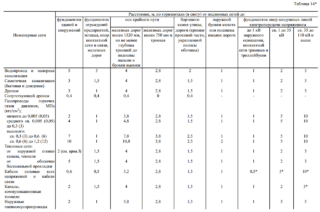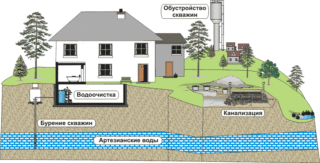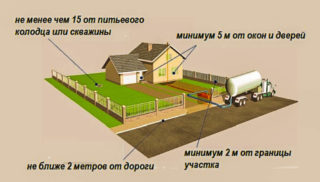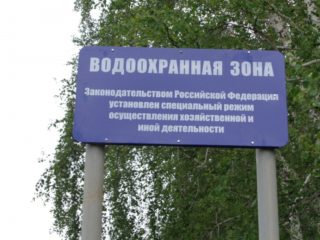When installing the water supply and sewerage system, the main emphasis is on the quality of the equipment, as well as on the observance of the distances between the communication branches and the foundation of the building. This is especially true for external highways - without strict adherence to the standards, it will not be possible to put the system into operation.
The location of the sewer in relation to the foundation

The distance from the sewer network to the base of the building is indicated at the stage of creating a project for utility lines. Compliance with the rules and regulations allows you to ensure safety for residents of the house and the operation of all systems without breakdowns.
The minimum distance of various engineering networks from the foundation of the house:
- pressure sewerage - 500 cm;
- drainage system - 300 cm;
- water supply - 500 cm;
- gravity sewerage - 300 cm;
- drainage line - 300 cm.
It is also necessary to take into account that wells for sewerage and water supply have a large diameter. The distance is taken from the base to the nearest well wall, not to the center of the structure.
Choosing a place to lay the sewage system
In private houses, it is mandatory to install a purification device, whose task is to remove contaminated water. A separate sewerage system implies two trenches for the discharge of wastewater: a storm water inlet and a household drain. Sewer pipes with a cross section of less than 50 mm are buried 30 cm from the level where the soil takes on zero temperature. From 50 mm and more, they require a half-meter deepening below the depth of soil freezing.
The layout of pipelines and the location of wells for sewerage are thought out in advance. For the rational placement of a septic tank, it is important to determine the location of the water intake well, and also do not forget about all the distances recommended by SNiPs and sanitary standards. Sewer wells are permanent structures for long-term operation. If initially installed in the wrong place, it is almost impossible to transfer them.
Such an approach to the construction of drainage systems allows you to reduce the risks of accidents, leaks and stagnation of effluents. When planning, you need to take into account:
- distance between nearby highways;
- remoteness from their own and neighboring buildings;
- distance to the street and highway;
- section of the sewer pipe;
- location of aquifers.
When placing a septic tank, be sure to take into account the prevailing direction of the winds throughout the year so that others do not suffer from an unpleasant smell.
- Draw up an accurate plan of all highways, taking into account the standards specified in SNiPs.
- Recheck whether the design data is in accordance with the graphical diagrams or drawings.
- Before laying new communication lines, check if there are old pipelines or sections of the power network at their location.
All these actions will help prevent problems with damage to the electrical cable, if it is present at the place of laying the pipes, as well as not break the existing lines in order to avoid accidents.
Mutual arrangement of underground utilities
When planning a drainage system, as well as water supply, first of all, familiarize yourself with the requirements of SNiP in relation to the minimum permissible distances between the networks.The vertical distances between the water supply and sewerage pipes are determined according to SP 18.13330.2011 clause 6.12. Horizontally - according to SP 42.13330.2011 clause 12.36. This takes into account the distance in the light - that is, between the most convex parts of neighboring objects.
According to these documents, the minimum distance must be observed:
- from the roadway to the water pipe - 2 m;
- between the basement of the house and communications - 4 m;
- from the mains of the water supply and sewerage system to the power line - 1 m;
- between water supply and sewerage routes and communication wires, power cables - 0.5 m;
- from trees to water supply pipes - 2 m, to the sewerage system - 1.5 m.

When crossing water supply networks and sewerage mains, the first ones are laid 40 cm above the sewerage system strictly at right angles. This measure allows you to protect the water supply system from the ingress of sewage into it.
Polymer water pipes are strong enough, but they will need additional protection at intersections. For these purposes, special cases with a length of 5 to 10 m are suitable.
If, for some reason, the laying of the water supply network is performed lower than the sewerage system, the drainage system is also provided with additional protection. The protective cover must be installed on the sewer pipe, taking into account the minimum vertical distance of 40 cm.
When installing new pipelines or repairing those already installed in places where there are already intersections of engineering communication lines, digging a trench with an excavator is carried out to a depth of no more than a meter to the upper highway.
The introduction of various hydraulic mains into the building requires a distance between them of at least 150 cm. Inside, the wiring is performed depending on the location of the riser. The horizontal distance between the sewer riser and the drinking water supply inlets should be at least 150 cm - with the diameter of the inlet pipeline up to 20 cm inclusive; 300 cm - with a cross section of more than 20 cm.
The project may include a separate drain from the gutter. Then two pipelines are laid. A similar option is performed when building large houses and cottages. The norms for the location of the stormwater are the same.
Arrangement of security zones
The second security zone will be organized around the sewer mains. The determination of its parameters is carried out based on the design of the sewage system, the level of seismic activity at the location of the building. The average distance is 5 m on both sides of the sewer main.
The sanitary zones of the point of water intake and waste water should not intersect.
For each region and region, standard distances between communication systems have been developed, taking into account the peculiarities of the terrain. It is necessary to follow these requirements when designing and installing water-bearing and spillway devices. If you do not take into account the distance in the light between the elements of the water supply and sewerage, there is a risk of contamination of drinking water, which can cause problems for human health and the environment.










